![]()
![]()
![]()
Use LEFT and RIGHT arrow keys to navigate between flashcards;
Use UP and DOWN arrow keys to flip the card;
H to show hint;
A reads text to speech;
48 Cards in this Set
- Front
- Back
|
It is the on-site breakdown or dissolving of rocks and minerals on the surface of the Earth |
Weathering |
|
|
It can be brought about by many agents such as water, ice, acids, salts, plants, animals, and changes in temperature. |
Weathering |
|
|
Can be CHEMICAL or MECHANICAL |
Weathering |
|
|
It is the physical breakdown of rock into unconnected grains or chunks without changing its composition. |
Disaggregation |
|
|
Key aspect of physical weathering |
Water |
|
|
Give 5 examples pf mechanical weathering |
Exfoliation Frost wedging Root wedging Salt wedging Human activities |
|

What type of mechanical weathering is this? |
Exfoliation |
|

What type or mechanical weathering is this? |
Root wedging |
|
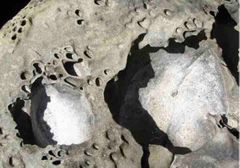
What type of mechanical weathering is this? |
Salt wedging |
|
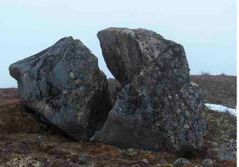
What type of mechanical weathering is this? |
Frost wedging |
|
|
It occurs when there are chemical changes in at least some of the composition of the rock. |
Chemical weathering |
|
|
In ________ rocks and minerals reacts to acids, oxygen, carbon and water. |
Chemical weathering |
|
|
Give 4 examples of chemical weathering |
Dissolution Carbonation Hydration Oxidation Hydrolysis |
|
|
It is a surface or near-surface process that is not influenced by high temperature or pressure. What reaction that causes the rocks to weather? |
Chemical reaction |
|
|
In ________ water breaks down mineral grains into the elements that make them up |
Dissolution |
|
|
It happens in certain minerals which are dissolved in water – pure water and acidic water- especially when it rains. |
Dissolution/ Carbonation |
|
|
Explain the process of dissolution/ carbonation and give one example. |
As rain goes through the air and into the ground, it grabs carbon dioxide, creating carbonic acid. This weak acid reacts with the calcium carbonate in stones when it seeps into the cracks Example: limestone |
|
|
________ is a type of chemical weathering where water reacts chemically with the rock, modifying its chemical structure. Water is absorbed into the crystal structure of the mineral, causing it to expand. |
Hydration |
|
|
True or fase Oxidation creates different types of rocks |
False - hydration |
|
|
It is the reaction of oxygen with minerals in the rock. |
Oxidation |
|
|
In _________ oxygen reacts with the original material to create new material. |
Oxidation |
|
|
True or false Hydrolysis is characterized by red, orange, and yellow stains that look like rust |
False - oxidation |
|
|
What is the most common example of hydrolysis |
Feldspar |
|
|
Where can u find the feldspar? |
Granite changing to clay |
|
|
In __________ elements in water (hydrogen and oxygen) replace elements in the original material, creating a new substance. |
Hydrolysis |
|
|
Give the three factors that affects weathering |
Climate Hardness Surface area |
|
|
It is the separation and removal of weathered rocks and soil due to gravity or transporting agents like wind, ice or water. |
Erosion |
|
|
It commonly occurs in flat,bare areas or dry, sandy, and loose soil |
Wind erosion |
|
|
It detaches soil particles and transports them by wind |
Wind erosion |
|
|
It is a permanent body of ice, which consists largely of recrystallized snow and shows evidence of movement due to gravity. |
Glacier |
|
|
The erosion process is dominant in ____________ and in high altitude mountains |
Polar regions |
|
|
is caused by the detachment and transport of soil by rainfall, runoff, melting snow or ice, and irrigation. |
Water |
|
|
True or false Glacier is the most common agent of erosion since it can pick-up millions of tons of sediments every day |
False - Water |
|
|
It is the downslope movement of rock, soil, and ice due to the force of gravity |
Mass wasting ( mass movement ) |
|
|
It is also a natural hazard that can cause damage to life and property |
Mass wasting ( mass movement ) |
|
|
Give 4 causes of mass wasting |
Increased steepness Increased water Decreased vegetation Earthquakes |
|
|
It is the process in which sediments settle out of the transporting medium |
Deposition |
|
|
What do you call the areas where sediments are deposited? |
SEDIMENTARY ENVIRONMENT |
|
|
Sedimentary environment can be _______ give 6 |
Glacial Desert Lake River Delta Beach Shallow/ deep marine environment |
|
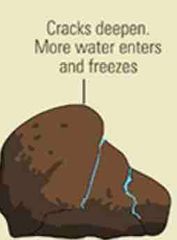
What step is this in weathering? |
Step 3 |
|
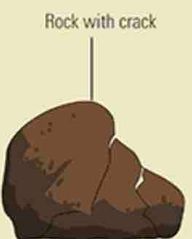
What step is this in weathering? |
Step 1 |
|
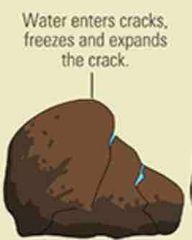
What step is this in weathering? |
Step 2 |
|

What step is this in weathering? |
Step 4 |
|
|
True or false As water spread out over the surface of the land, (grow), they can change the shape of the land. |
False - glacier |
|
|
True or fase Weathering can be chemical or mechanical |
True |
|
|
Give one example of wind erosion |
Sand dunes in panay, ilocos norte |
|
|
Essay
How do rocks and soil move down slope? |
Goodluck kaya nyo yan |
|
|
Essay
How are the different sedimentary environments affected by deposition? |
Kaya nyo yan di ko alam sagot bub JAHAHAAHAH |

